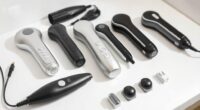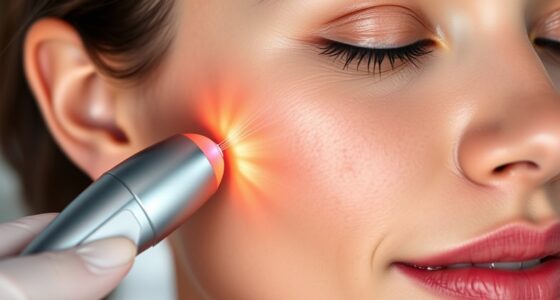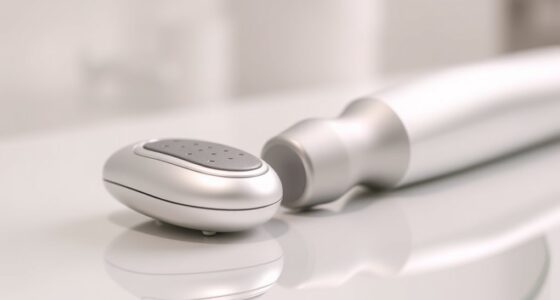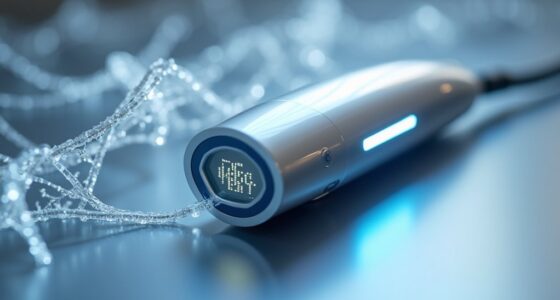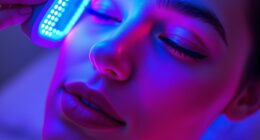Radio-frequency treatments tighten skin faster because they stimulate collagen production more intensely and quickly, with visible results often appearing within weeks after 4–6 sessions. Microcurrent therapies, on the other hand, offer gentler, more gradual improvements that can take several weeks or months to notice. If you want quick, noticeable skin tightening, RF is usually the better choice — but exploring your options further can help you make an informed decision.
Key Takeaways
- RF stimulates collagen more intensely, providing faster visible skin tightening than microcurrent treatments.
- RF treatments typically show results within weeks, while microcurrent effects take several weeks or months.
- RF sessions are usually shorter but more frequent for quick improvements, unlike microcurrent’s longer, gentler sessions.
- Microcurrent offers a gradual tightening effect, requiring more time to achieve noticeable results.
- Overall, RF is the faster option for skin tightening compared to microcurrent therapy.
How Radio-Frequency Stimulates Collagen Production
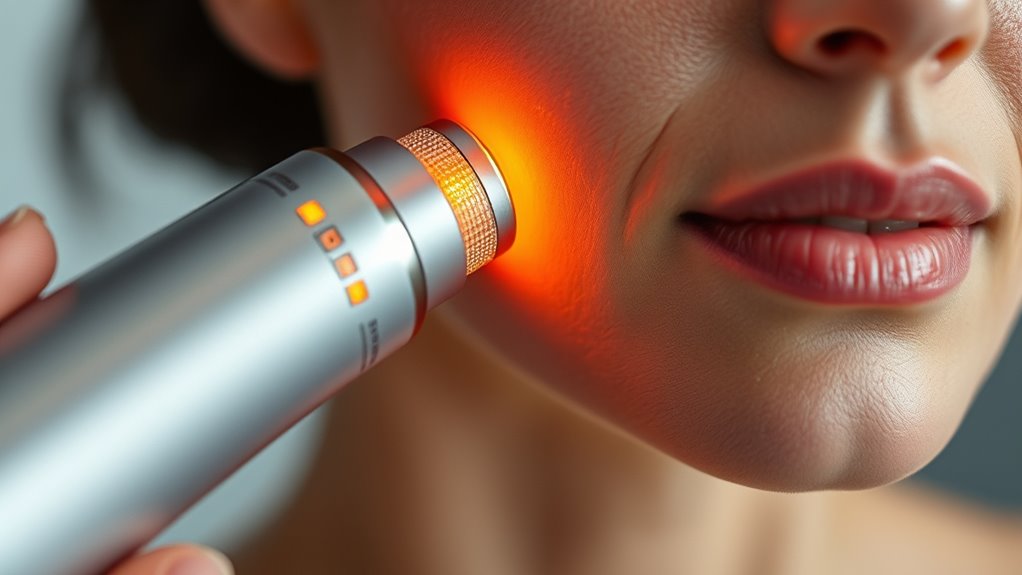
Radio-frequency (RF) treatments stimulate collagen production by delivering controlled heat deep into the skin’s layers. This heat triggers chemical reactions within your skin cells, encouraging collagen fibers to tighten and rebuild. The process relies on electrical currents that generate this heat through resistance in the tissue, causing a precise increase in temperature. As the heat penetrates, it activates your body’s natural healing response, boosting collagen synthesis. The electrical currents used in RF treatments also help break down existing collagen bonds, allowing new, healthier fibers to form. Additionally, contrast ratio plays a role in the visual perception of skin firmness and tightness, as improved contrast can enhance the appearance of skin texture. The result is firmer, tighter skin over time. RF treatments work by harnessing these chemical reactions and electrical currents to stimulate your skin’s natural regenerative processes, making it an effective option for skin tightening without invasive procedures.
The Mechanism Behind Microcurrent Technology
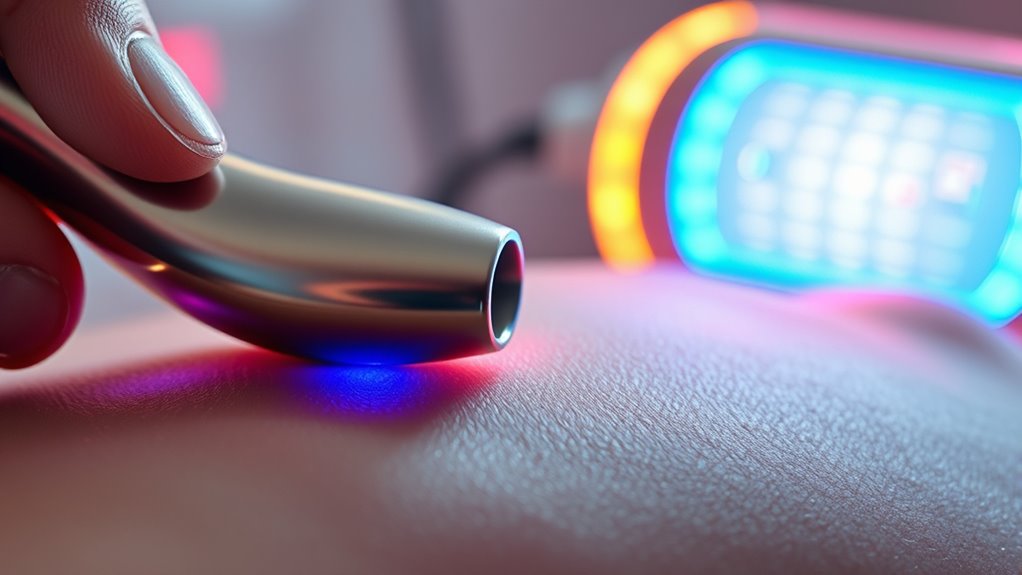
Microcurrent technology works by delivering low-level electrical currents to your skin, mimicking the body’s natural bioelectric signals. This electrical stimulation encourages your cells to function more efficiently, promoting cellular rejuvenation. When the microcurrents penetrate your skin, they stimulate your facial muscles, helping to lift and tone without invasive procedures. Additionally, this process enhances ATP production, which supplies energy to your skin cells, supporting repair and regeneration. As a result, your skin appears firmer, more vibrant, and revitalized. Because it promotes natural cellular activity, microcurrent therapy offers a gentle yet effective way to improve skin tone and elasticity over time. This mechanism makes microcurrent a popular choice for those seeking non-invasive skin tightening. Moreover, the integration of automation technologies in skincare devices can further enhance treatment precision and outcomes.
Comparing Speed of Visible Results
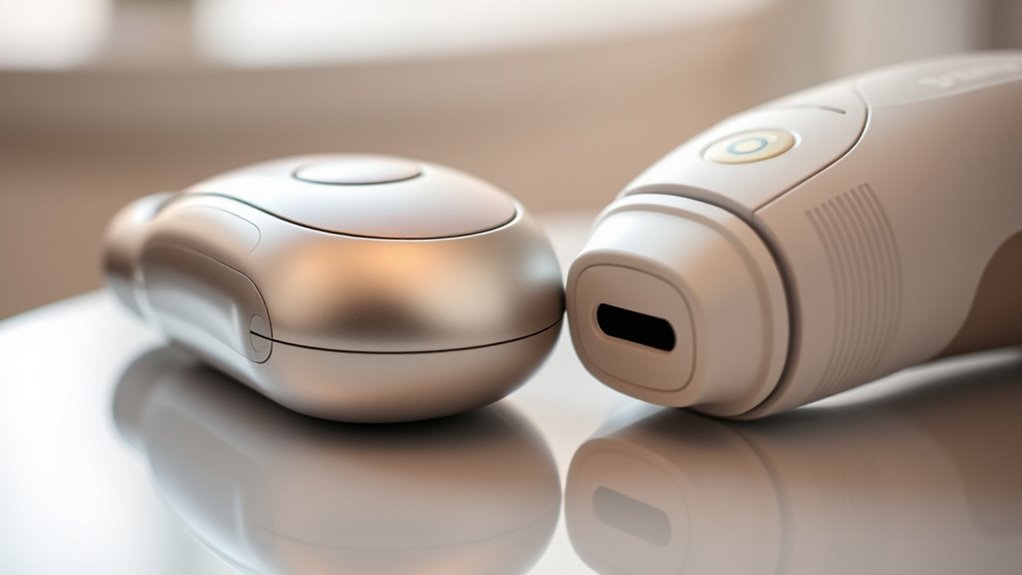
While both radio-frequency and microcurrent treatments can improve your skin, they differ markedly in how quickly you see results. Radio-frequency typically offers visible tightening effects after fewer sessions, often within a few weeks, making it ideal if you want faster results. Microcurrent treatments may take longer—sometimes several weeks or months—before noticeable changes appear. When considering cost comparison, radio-frequency devices often require fewer sessions, potentially saving you money over time. User convenience also plays a role; radio-frequency devices are generally quicker and easier to use at home, providing faster results with less effort. Microcurrent treatments might involve longer sessions and more frequent visits, which can delay visible improvements. Your choice depends on how quickly you want to see results and what fits your budget and routine. Skin tightening effectiveness can also depend on your individual skin type and condition, making personalized consultation beneficial.
Factors Influencing Treatment Effectiveness
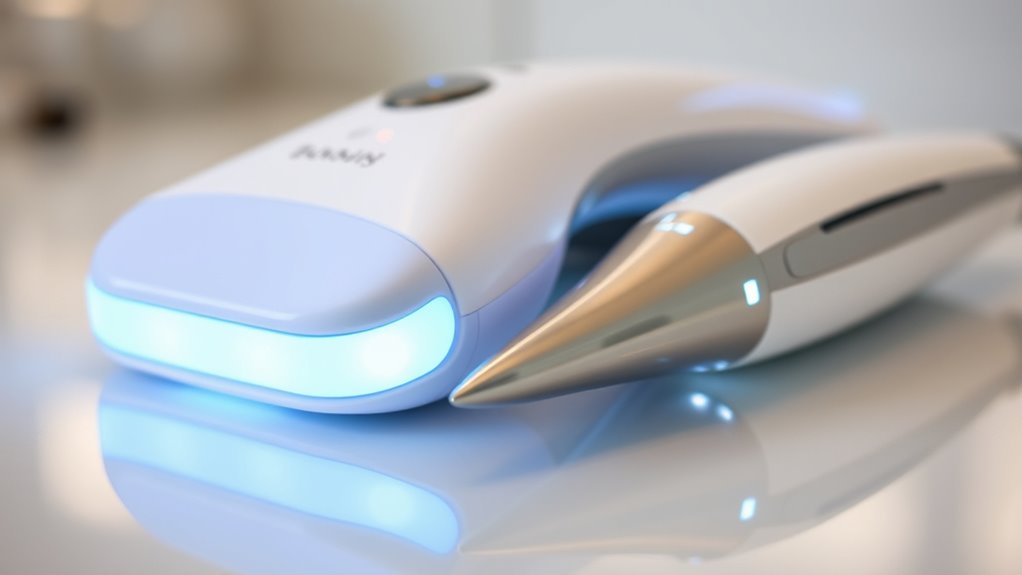
Your skin type plays a big role in how well these treatments work, so choosing the right one is key. Adjusting device intensity settings guarantees safety and effectiveness, while treatment frequency and duration can impact your results. Paying attention to these factors helps optimize your experience and outcomes. Considering your skin sensitivity can also influence which device settings and treatment plans are safest and most effective.
Skin Type Compatibility
Skin type plays a crucial role in determining how effective radio-frequency and microcurrent treatments will be for you. If you have sensitive skin, microcurrent might be gentler and reduce the risk of irritation, making it suitable for delicate skin types. Conversely, those with less sensitive skin may find radio-frequency more effective, as it can penetrate deeper to stimulate collagen production. If you’re acne prone, microcurrent could help improve skin tone without aggravating breakouts, but some devices may trigger sensitivity. Radio-frequency treatments might be more suitable if you want faster tightening, but they may cause temporary redness or discomfort in sensitive or acne-prone skin. Always assess your skin sensitivity and consult a professional to choose the treatment that aligns with your skin type. Additionally, considering vetted products for safety and effectiveness can help ensure you select the best device for your needs.
Device Intensity Settings
Device intensity settings play a significant role in the success of radio-frequency and microcurrent treatments. Proper device calibration ensures that you deliver the correct energy levels, maximizing effectiveness while minimizing discomfort. If the settings are too low, you might not see the desired skin tightening results; too high, and you risk irritation or pain. Adjusting the intensity to match your comfort level is vital—your skin should feel a warm sensation without pain. Many devices allow you to customize these settings, so don’t hesitate to start at a lower level and gradually increase as your skin adapts. Clear calibration and mindful adjustments help optimize treatment outcomes, making your sessions both effective and comfortable. Understanding sound design techniques can also help in creating a calming environment during treatments, enhancing overall relaxation and comfort.
Treatment Frequency & Duration
The frequency and duration of treatments considerably influence their overall effectiveness. You need consistent sessions to see noticeable results, but overdoing it can lead to diminishing returns or discomfort. Maintaining patient compliance is essential, so sticking to recommended schedules ensures maximum skin tightening. Longer treatment courses may improve outcomes but also increase cost considerations, so balance is key. Fewer sessions might save money but could delay visible improvements. Typically, weekly treatments for several weeks are ideal, but individualized plans depend on your skin’s response and goals. Regular sessions help build momentum, maximizing results efficiently. Remember, consistency and adherence to your provider’s guidance are indispensable for tightening skin faster and more effectively. Incorporating treatment frequency strategies based on your unique needs can further optimize results.
Typical Treatment Duration and Sessions
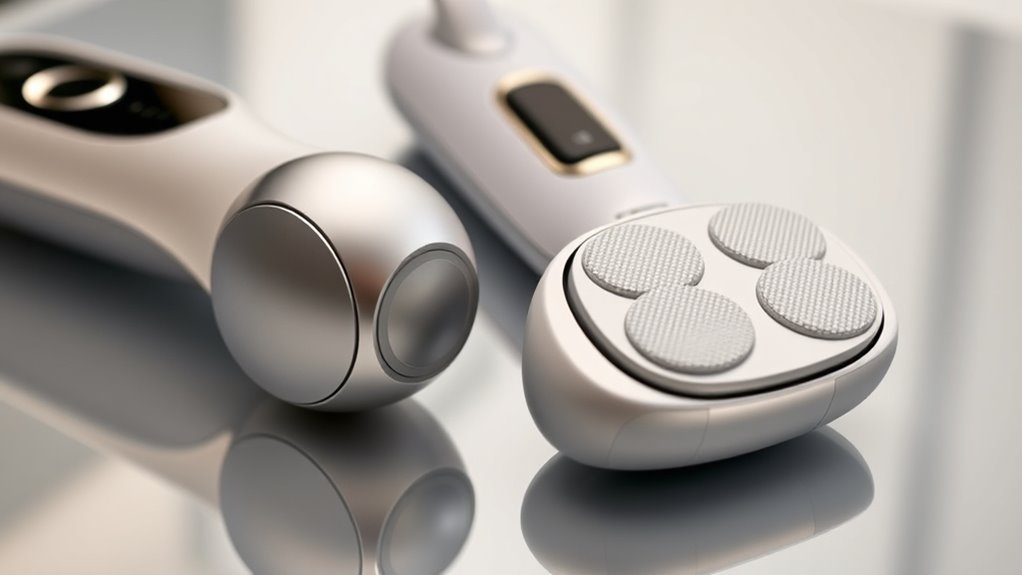
Typically, radio-frequency treatments require multiple sessions spread over several weeks to achieve noticeable results, with most patients undergoing 4 to 6 sessions. Each session usually lasts about 30 to 45 minutes. Microcurrent treatments tend to be shorter, often 20 to 30 minutes per session, with similar session counts. The overall treatment plan affects the cost comparison, as more sessions increase expenses. Customer satisfaction varies depending on individual goals and expectations, with some preferring the quicker results of radio-frequency, while others favor the gentler microcurrent approach. Here’s a comparison:
| Aspect | Radio-Frequency | Microcurrent | Notes |
|---|---|---|---|
| Duration per session | 30–45 minutes | 20–30 minutes | |
| Number of sessions | 4–6 | 4–6 | Similar session counts |
| Cost comparison | Higher overall | Lower overall | Influences preferences |
| Customer satisfaction | Often high, faster results | Usually positive, subtle effects | Depend on individual needs |
Additionally, the choice may depend on treatment speed preferences and budget considerations.
Which Method Offers Faster Skin Tightening?
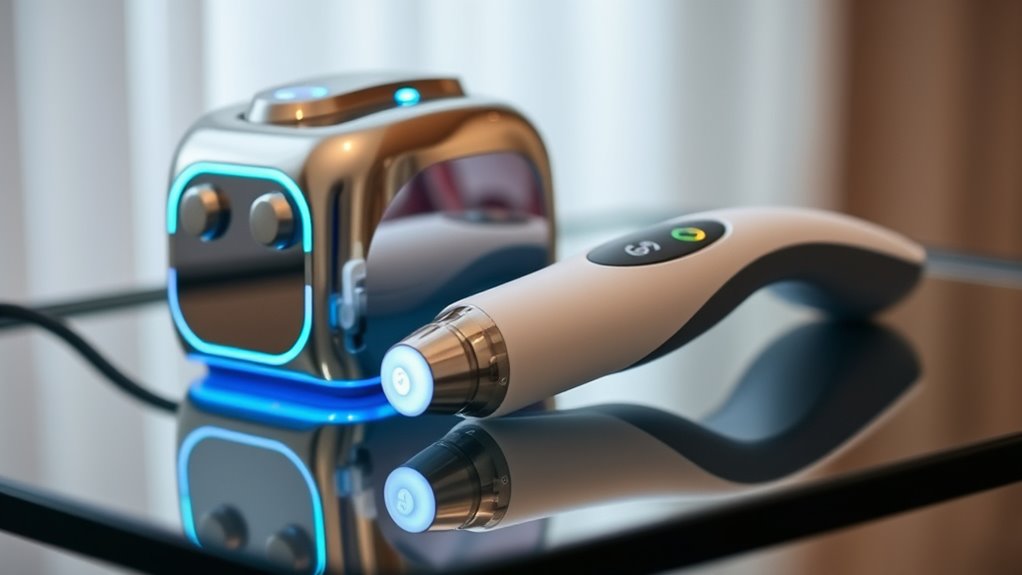
When it comes to skin tightening, radio-frequency treatments generally produce faster results than microcurrent therapies. RF devices stimulate collagen production more intensely, leading to noticeable changes in a shorter timeframe. If you’re seeking quicker skin firmness, RF might be the better choice. However, cost considerations play a role; RF treatments tend to be more expensive per session but often require fewer visits. User comfort also matters—RF treatments can cause mild discomfort or warmth during sessions, but many find it tolerable. Microcurrent therapies, while gentler and more affordable over time, usually deliver more gradual results. If speed is your priority, RF offers a faster path to tighter skin, but balance that with your budget and comfort preferences. Proper device maintenance and care can also influence treatment effectiveness and longevity.
Frequently Asked Questions
Are There Any Significant Side Effects for Either Device?
When considering side effects, both devices generally have a good safety profile, but some individuals might experience mild discomfort, redness, or swelling. You should check device compatibility with your skin type and consult a professional to confirm safe treatment. While serious side effects are rare, understanding treatment safety helps you make an informed decision and minimizes risks, making the process safer and more effective for your specific needs.
Can These Treatments Be Combined for Better Results?
Think of your skin treatments as a symphony—when you combine them, the harmony can be striking. Combining radio-frequency and microcurrent treatments offers treatment synergy, enhancing collagen production for faster, more noticeable tightening. The combination benefits include improved skin texture and firmness, with minimal downtime. Always consult your specialist to create a personalized plan that safely maximizes results, ensuring your skin’s journey to youthfulness hits a high note.
How Do Costs Compare Between RF and Microcurrent Devices?
When comparing costs, you’ll find that device affordability varies. Microcurrent devices often come with a lower upfront price, making them more accessible for at-home use. Radio-frequency devices tend to be more expensive, especially professional-grade models, but they might deliver faster or more noticeable results. Consider your budget and goals, as the cost comparison depends on whether you want professional treatments or at-home options for skin tightening.
Are There Specific Skin Types That Respond Better?
Imagine matching a key to a lock—that’s how skin type compatibility influences treatment success. You’ll find microcurrent works best for sensitive, thin, or fragile skin, providing gentle stimulation. Radio-frequency suits thicker, more resilient skin, offering deeper tightening. Personalizing treatments based on your skin type guarantees better results and minimizes side effects, so always consult with a professional to tailor your approach, making your skin’s unique needs the priority.
What Are the Long-Term Maintenance Requirements?
You’ll need to follow specific maintenance routines to keep your skin tight over time. Upkeep frequency varies, but typically, ongoing treatments every few months help maintain results. Consistent skincare, sun protection, and healthy habits are essential for long-term benefits. Be sure to consult your practitioner for personalized advice, as they can recommend the best maintenance routines to preserve your skin’s firmness and ensure your investment lasts.
Conclusion
So, which method really tightens your skin faster? Both radio-frequency and microcurrent have their perks, but if you’re after quick, noticeable results, radio-frequency might be your best bet. It stimulates collagen more rapidly, giving you that firmer look sooner. Are you willing to invest in longer sessions or prefer faster improvements? Ultimately, choosing depends on your goals and patience. Whichever you pick, consistency is key to achieving the best skin tightening results.

